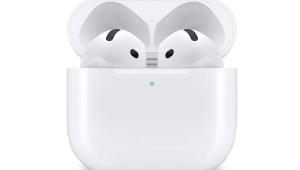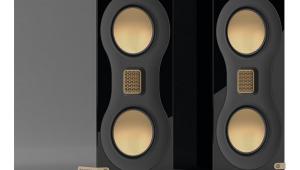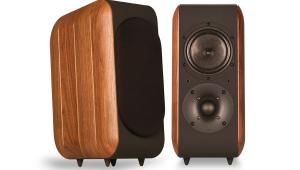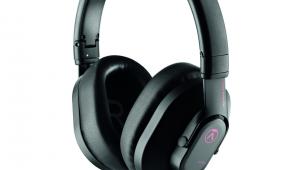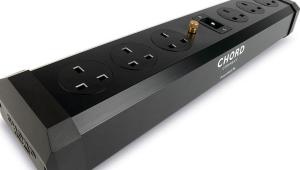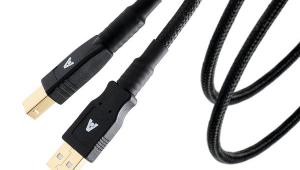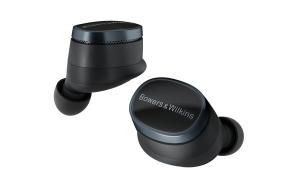Guide to... System matching

System matching
Part of the key to a successful setup is finding the perfect partnership, here’s how...
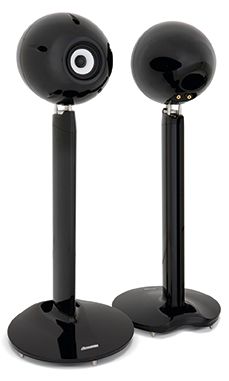 It’s funny how much time and money can be devoted to buying hi-fi systems without stopping to consider one of the most critical determining factors for sound quality – that of amplifier-speaker matching.
It’s funny how much time and money can be devoted to buying hi-fi systems without stopping to consider one of the most critical determining factors for sound quality – that of amplifier-speaker matching.
How many of us spend any real time contemplating the electrical match between our amplifiers and the loudspeakers we’ve chosen to partner them with? Ironically though, this is key to getting a serious sound from your hi-fi. You’ll never get the best out of your amp if you’re forcing it to huff and puff driving unsuitable speakers, and nor will you ever hear your loudspeakers sing with an amplifier that was chosen without regard to whether it could drive them properly.
Perfect partnership
It’s hard to overstate the importance of this relationship between the two prime movers of your hi-fi system. One good analogy is that of trying to steer a car with sweaty hands sliding around a plasticky steering wheel. Another is trying to walk on sheet ice with shoes better suited to ballet dancing. These are two ‘interfaces’ where the contact points are simply not right for one another – they can’t work at anything near optimum efficiency – and consequently the job can’t get done right. The same goes when partnering a mismatched stereo amplifier and loudspeakers, often resulting in bad sound.
To get the chemistry right between amplifier and speaker, you’ve first got to focus on the physics. This is, of course, because speakers make noise by moving air; they’re transducers that convert electrical energy from your amp into a physical form. How much sound they produce (the amount of air they move), depends on a number of things. First, the design of the loudspeaker. In simple terms, designing a speaker is about weighing up factors such as sensitivity, bass extension and transient speed. The art is in the compromise between these factors and indeed the finest sounding speakers are those that often require the most artful compromises!
Sensitivity is the amount of sound a speaker produces from a given amount of power. This is a function of the drive unit design and the cabinet loading type, plus the size of the cabinet. These factors really must be considered by anyone thinking about purchasing a loudspeaker, or trying to match one to an existing amplifier.
Conventional drive units come in all sorts, some have powerful, efficient magnets and motor designs and others don’t. From a buyer’s viewpoint these aren’t easy to tell apart, but one thing to look out for is the type of cone material used. This has a direct effect on sound; heavier materials will need more amplifier power to move the same amount of air. By contrast, paper is light so needs relatively little power; this was popular in the sixties when amps were mostly low powered.
These days, Kevlar (used in B&W speakers, for example) along with carbon fibre, glass fibre and aerogel, also make for speakers that convert power to sound efficiently.
In the air tonight
A key factor determining speaker sensitivity is the type of cabinet loading used by the loudspeaker. This is chosen by the designer to get the sound characteristics he’s trying to achieve with his chosen drive units. Many hi-fi speakers are reflex ported (ie with a hole or slot in the cabinet, known as a ‘port’). Ports allow drive units to move air more easily, in general terms giving higher sound levels for each watt of power fed in. Some designers choose infinite baffle cabinets, where the speaker box is sealed to the outside world. This can give a tighter bass in some rooms, but tends to drink up more power. So as a general rule, it’s better to match lower-powered amps to reflex ported loudspeakers, while infinite baffle speakers require a big powerful amp.
 Size matters
Size matters
Another point to make at this stage is that, whatever the type of cabinet loading used in the speaker, the larger the internal volume of the cabinet, the easier it can move air. That’s why large loudspeakers tend to be more sensitive. So it’s fair to say that, all other things being equal, a large reflex ported loudspeaker with good modern drive units and light cones will produce higher sound levels for the same amount of power than a small, infinite baffle type with less efficient drivers. This is the key point to keep in mind when choosing the right speakers for your amp, or vice versa.
That said, it’s all very well buying a ‘best buy’ amp and speakers, but they won’t necessarily work well together. It’s not just the components that make your system sound good, it’s how they interact. The secret’s in the matching.
So, before you even think of amplifier power as being a guide to how loud your system will go, you must consider loudspeaker sensitivity – it’s just as important as your amplifier power output rating in determining the overall effect. The standard method of measuring speaker sensitivity is to state the sound pressure level that they generate (in units called dBA) at a distance of one metre from one watt of input power. Although it is seldom stated, the test frequency is a 1kHz midband tone, which is assumed to be a fair frequency where the speaker is likely to be even.
Here’s where the art of system matching comes in. If you use valve amps, you’ll likely need a speaker of at least 89dB or more sensitivity to get more than a squeak. So it will probably be a large, ported design. Conversely, if you want small loudspeakers in your house, then you’re going to have to get yourself a big, powerful transistor amplifier of at least 60W per channel or more.
Effectively then, the more power your amp has, the less important speaker sensitivity is, as one compensates for the other. That’s why most people running modern transistor amplifiers of a medium power output can run most loudspeakers without undue trouble. But even these days, smaller amps in big rooms will still find it helpful to opt for more efficient loudspeaker designs. A typical figure for an average loudspeaker is 86 to 88dBA/1W/1m, and this will go loud with an amplifier rated at around 25W or more.
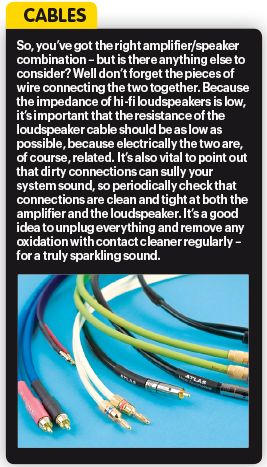
Deciphering the numbers
There’s more to amplifier power figures than meets the eye. Every hi-fi buyer has to suffer the ordeal of the numbers game – from cheap eighties stack systems to nasty nineties mini systems and fancy noughties car systems, the makers sell their wares by boasting ‘2x 50W’, ‘4x 40W’,
or whatever. So how to decipher published power output figures, and how do they work in practice? Well, they’re a useful insight into what the amplifier’s got inside it, especially when you read between the lines. Real hi-fi manufacturers will quote their amplifier power output into differing speaker impedances, the norm being 8ohms. Remember though that this is just a ‘line in the sand’; no speaker presents an 8ohm load to the amplifier at all times; as its impedance is constantly varying up and down with frequency. That’s why its useful to check the amount of power it puts into 4ohms, and even 2. Amps that have really well-designed power supplies will deliver almost twice as much power into half the load, so 20W into 8ohms becomes 40W into 4ohms and 80W into 2ohms. Very few exist that do this, but the closer they get to this, the more the amp is able to drive ‘real-world’ speakers, rather than just a steady state test tone on the laboratory bench.
The other side of this is, of course, loudspeaker impedance. Most modern speakers have a quoted impedance of 8ohms, but as they play music some can go down a lot lower. An amplifier that puts out twice as much power into 4ohms as 8 is going to sound stronger and more stable, rather than weak kneed and limp. With a big transistor amplifier that (nearly) does this then, you don’t have to worry about your speaker’s quoted impedance so much – it isn’t absolutely critical. Conversely, using 8ohm loudspeakers with an amplifier that is specified for 4ohm speakers will result in a reduction in numerical power output, but this is seldom noticeable in practice, and remember that loudspeaker impedance varies greatly with frequency over the audio band anyway. The situation is more critical with valve amplifiers due to the low power levels that can be achieved, even under ideal conditions. Typically a choice of loudspeaker terminals of different impedances are fitted (called ‘taps’), and these should be used correctly.
Another thing to consider is the power rating of your speakers, although to be fair this isn’t critical in practice. A loudspeaker rated at 150W does not imply that either you need a 150W amplifier to drive it or that it will fail if 151W are applied. It is, however, a good basic guideline that indicates the scale of amplifier that the manufacturers had in mind when designing the loudspeaker. So try and pick one which is, at least, within a factor of two of the power of your amplifier. It is interesting to note that more loudspeakers are damaged by amplifiers that are not powerful enough, rather than too powerful, this is because when an amplifier runs out of puff it starts to generate a lot of distortion, which passes straight through the loudspeaker’s crossover filters and damages the tweeters. That’s why some speaker makers also quote a minimum amplifier power rating too. Finally, remember that power rating does not give a direct indication of how much sound the loudspeaker will generate with a given amplifier; sensitivity is usually the better indication of that.
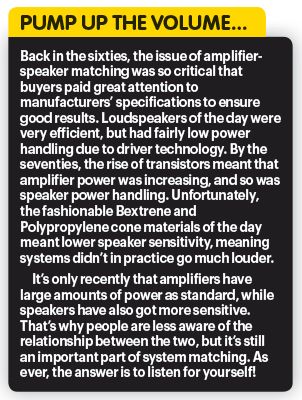 Rising damp
Rising damp
Now we’ve got the basics covered, here’s another measurement that’s useful for predicting how your amplifier and speaker partnership is going to sound – damping factor. It’s the name given to the ratio between the loudspeaker impedance and the amplifier’s output resistance. Think of it as how much the tail wags the dog. If the damping factor is too low the amplifier will not be able to position the loudspeaker cones accurately and the resonances of the loudspeaker will colour the sound – the speakers begin to affect the way the amp works electrically. Sometimes this leads to
a pleasant increase in perceived warmth, but it can often dull the system’s ability to communicate rhythm and timing and lead to boomy, ‘one note’ bass.
While valve amps can sound magical, their Achilles’ heel is their poor damping factor, which is why amp-speaker matching is so critical here. The damping factor of valve amplifiers tends to be low – between 0.5 and 5 for many of the current models. There are all kinds of technical reasons for this, from their lack of strong negative feedback and the resistance of the wire in their output transformers. Transistor amps can be constructed to give colossal damping factors; one reason that the popular Audiolab 8200A integrated works well with a wide range of loudspeakers is its high damping factor, which is over 50. Powerful transistor amplifiers with high damping factors are more able to give predictable results with ‘peaky’ loudspeakers that exhibit large impedance changes across the audio band, while tube amps need more even-natured speakers to give their best. All this is related to the amplifier’s output impedance – the higher this is, the greater the variation in system (amp and speaker) response will occur, reflecting swings in the loudspeaker’s impedance curve. In some quarters, the subjective impact of the output impedance on perceived bass performance is less of an issue. Ultimately then, the only way you can really be sure your speaker is electrically well matched to your amp is to listen to it, which underlines what we always say – get to know a good dealer and audition your desired kit with a range of music.
 |
Inside this month's issue:
Ruark R610 music system and Sabre-R standmount speakers, PMC twenty.23i Active, floorstanders, English Acoustics Downton preamplifier, Bluesound NODE ICON preamp/streamer, Ortofon Concorde Music Blue MM cartridge and much, much more
|


























